Sony A200: Entry DSLR Roundup
by Wesley Fink on October 20, 2008 1:00 AM EST- Posted in
- Digital Camera
Field Notes
In our review of the Sony A350 we complained about the optical viewfinder just about as much as we praised the Live View tilt LCD. The Sony A100 had one of the better APS-C viewfinders, so the "tunnel-vision" A350/A300 viewfinder was quite a disappointment by comparison. It was clear Sony had to make compromises in the optical viewfinder to accommodate the Penta-Mirror shift and dedicated Live View sensor used in the A350/A300.
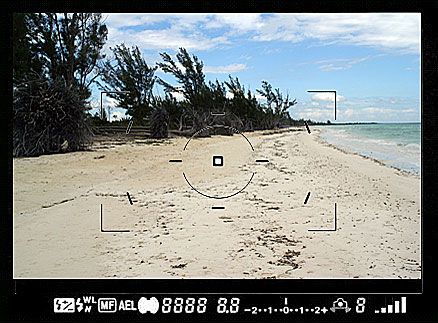
The A200 returns us to the big bright viewfinder of the A100. In fact, to our eyes the viewfinder appears unchanged from the A100 model, which is certainly a good thing. You also get a higher image magnification and a greater percentage of the total frame in the A200 viewfinder and on the LCD than you do on the A350/A300. This gives buyers a real choice. Traditionalists will prefer the A200 viewfinder, which is at least as good as anything in its class. Those who want a fast working Live View camera can choose the A350/A300, but users cannot get both a great optical viewfinder and great Live View in any current Sony camera.
Frankly, most of the competition's Live View implementations are slow as molasses and are not even close to the Sony A350/A300. However, they can be useful in non-action shooting situations or in the studio where the image magnification on the LCD can be very helpful for some critical focusing situations. Of course, who buys an entry DSLR for their studio? Today's Live View is more a checklist feature than a truly useful feature on entry cameras except the Sony A350/A300.
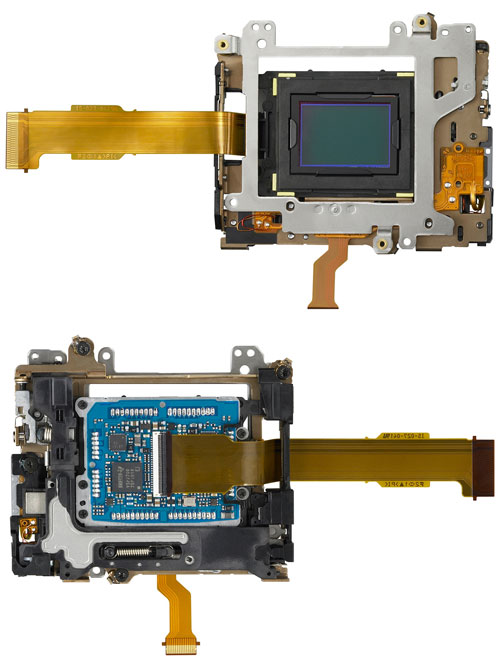
Image Stabilization and Auto Sensor-Cleaning Minolta was first with body-integral image stabilization and Sony has further refined a feature that most everyone but Canon and Nikon have adopted. It works very well on the A200 with up to 2 to 3 stops of added handheld capability. The Sony A200 IS works with any lens you can mount to the camera, and this includes current Sony lenses as well as millions of Minolta AF lenses that are often quite reasonable on the used market and on eBay. That same body IS also allows automatic sensor cleaning, which seemed to work well in under a wide variety of conditions. Our test cycle was just a few weeks but dust was never a problem with the A200 even though we used a wide variety of lenses in our testing.
Auto Focus In addition to more focus points and better focus tracking than many of their competitors, Sony claims the A200 Auto Focus is 1.7X faster than the A100. This is due to a higher torque motor and AF improvements borrowed from the newer A700. The AF module itself appears the same as the A100, but the AF speed in a side-by-side with the A100 found the A200 quite a bit faster in focusing. The A200 is not A700 fast, but the A700 is one of the fastest available in its class. However, compared to other entry models the A200 is one of the fastest focusing models.

Image Quality The Sony sensor is one of those components that promises more than expected if compared on price alone. The Sony 10.2MP CCD is a mature sensor that has been on the market for about two years. It is revised, refined, and coupled with a fast, recent Bionz processor in the A200. As a result, the A200 has a wider ISO range than others in the $499 price class. If you move up a notch to the $599 class the A200 still holds its own in image quality against any competitor. Image quality of the A200 is excellent, consistent, and dependable - which is a nice combination in an entry DSLR.
Controls The A200 is a model of simplicity in controls, but that should not be misread as lacking adjustment control. There is only one dial, where you select the all-auto mode, Program, Aperture-Priority, etc. and the Scene Modes.
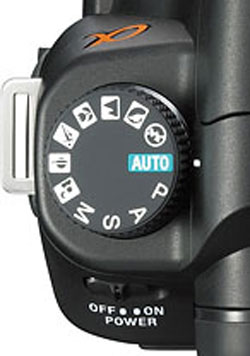
In Program mode there is a shift feature that is easy to use to control exposure. Turning the single front dial maintains the auto exposure but shifts the shutter speed (and corresponding aperture) to give more exposure choices. The single command dial is a concession to entry level, as was the single dial on the A100. The A700 has two dials with the front shifting shutter and the rear aperture in program shift. However, you can choose to have aperture instead of shutter as the shift parameter in the A200 menus.
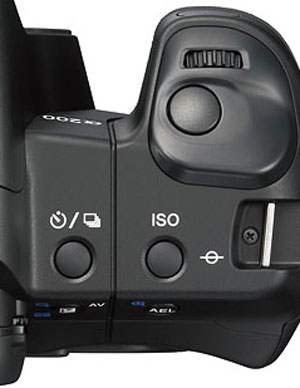
The top right features buttons for instant selection of ISO and Drive mode. The values are displayed on the rear LCD and can be adjusted with the joy-pad.
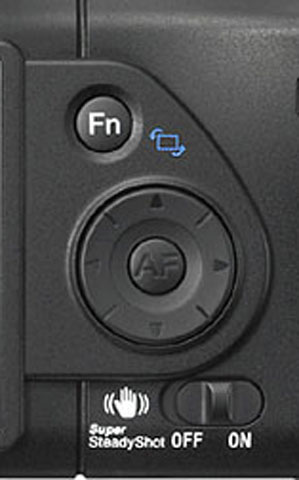
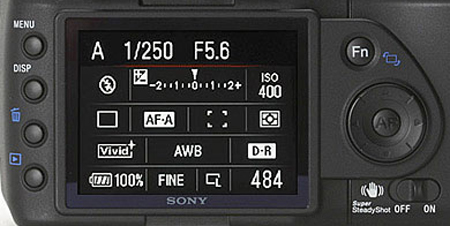
One of the nicest features of Sony DSLRs is the Fn button to the right of the LCD. This button brings up the Fn screen which allows adjustment of all the major parameters of the camera in one convenient place. Recent models from other manufacturers are featuring a similar feature, with the Canon 50D the most notable convert to the menu-less one screen adjustment summary.
DRO (Dynamic Range Optimizer) The Sony A200 is not a stripped entry model as many of its competitors are. The best example of this is the fact that Sony includes their DRO feature in the A200, which allows dynamic range expansion in captured images. It is even adjustable in the A200. This is certainly not a feature you would normally expect to find in an entry DSLR.
Ease of Use Sony has earned a deserved reputation in the DSLR market for simplicity or ease-of-use. We suspect this is more the result of the influence of Minolta engineers than Sony designers since the Sony point-and-shoots are often extremely complex and unintuitive. We do hope that Sony DSLR ease-of-use continues in the future.
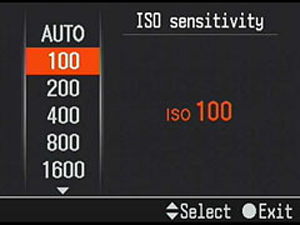
Auto ISO is another Sony feature that is very useful. In Auto ISO the camera selects the ISO to keep the exposure in a range that will likely produce sharp pictures. The Auto range is optimized and varies depending on the shooting mode selected or the Scene selection. Unlike some competitors, Sony has not really crippled the A200 or removed features to match a lower price point. All of the A100 features and options are continued or expanded in the A200 except for the Depth-of-Field preview button on the front, which was a victim of cost-cutting. But the ISO range is wider and the operation is even faster than the well-respected A100.
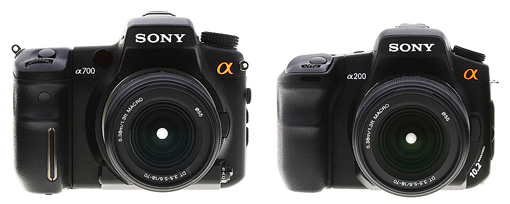
Handling The A200 is certainly smaller than the prosumer A700, but it is still larger than the similarly priced Nikon D60 and Canon XS entry models. Weight, however, is similar to these two competitors. Frankly, some have real issues with the small size of the D60 and Canon XS and prefer the Canon handling with the optional battery grip. Of course, the Nikon does not offer an optional battery grip so the D60 can't grow for better handling.
The A200 is a bit larger than the Canon and Nikon entry and fits larger hands better. If you find the XS/XSi and D60 too small for your liking, you will like the Sony A200 handling. Sony also makes an optional Battery Grip for the A200, and it is the same grip that fits the A300/A350. The A100 did not have a grip option.
Overall the ergonomics of the A200 seem to be right on target. It is easy to hold and operate and it is a further refinement of the A100 it replaces. If size is your main concern, however, the Canon, Nikon, and Olympus entry models are even smaller, though some complain they are too small for a DSLR and hamper ease-of-use.
Customization The A200 is one entry model that certainly does not look or behave like one. The only hints that this is not a midrange model are the lack of a depth-of-field preview button and just one command dial. However, features and options are otherwise what you would expect on a much more expensive camera. Bracketing control is present and not missing like the Nikon D60. Wireless flash control is present, unlike the Nikon D60 or the Canon XS, as is body image stabilization, unlike the Olympus E420.
As already pointed out Live View is not an A200 feature. If that matters to you move up to the A300 at $599. The A300 uses the same sensor as the A200 and features a real fast focus tilt LCS for Live View. If the real usefulness of the Live View is not so important you could select one of the A200 competitors in the entry class, all of which feature slow Live View as a feature for sometimes use.










32 Comments
View All Comments
JarredWalton - Monday, October 20, 2008 - link
I think particularly in the entry level DSLR arena, using the included lenses for images is important. The pictures of even a moderate DSLR with kit lens should easily surpass what most P&S cameras can manage, which is one of the big attractions. As soon as you get into lenses, however, you open up a huge can of worms.As for the subject material... well, I'll leave it to the photography buffs to debate what should be used. I believe Wes is working on some photos showing what the A200 can do out of a static test environment, but in order to provide any semblance of apples-to-apples shooting comparisons I think you need to do something like the shots Wes uses. I know I for one wish the white balance on my XTi did better under Tungsten lighting.
nowayout99 - Monday, October 20, 2008 - link
"...it is easy to forget that many buyers are looking for the absolute best "bang-for-the-buck" in a camera."Really...? Therein lies a divide between AT and readers. Articles for high-end products really aren't appealing to that many people, yet that's almost all we've gotten for cameras.
Even this $500 cam is pretty high-end priced for the vast majority of people that just want something they can take around with them for fun. How about some comparisons of joe schmoe cameras?
strikeback03 - Tuesday, October 21, 2008 - link
On Sunday a friend and I went to a local state park to get some pictures of the leaves. He owns a Canon SD600, a relatively decent couple year old P&S. At one point he was asking me to get some close-ups of a rock face, so instead I tossed my Sigma 18-200 OS on my Rebel XT body (wasn't using either) and let him play with those. I think he is now in the market for an SLR, as some comparison shots he did with his SD600 just blew him away, and that was just in basic JPEG mode.GTVic - Monday, October 20, 2008 - link
This is what epinions and CNET is for. I don't think you will find too many serious reviewers who want to spend their time keeping updated on the sub $200 camera market. It is not interesting, there are too many cameras to keep track of and not many people do serious research on that level of purchase.adder - Monday, October 20, 2008 - link
well i hope u guys do some lens reviews,and for people who are going in for a entry level dslr may not know much about lenses other then the kits lenses.strikeback03 - Monday, October 20, 2008 - link
Is the grip the same as the A100? Between the length and positioning of the shutter release/dial, I found the A100 quite uncomfortable to use. For me either the shorter bodies like the Canon Rebels or the taller ones like Nikon D80/Canon 40D are far more comfortable.FATCamaro - Monday, October 20, 2008 - link
It is a great point and shoot camera. I use mine a LOT and couldn't be happier. I use it as a point and shoot except for ISO and flash control. The ISO control is incredible simple and useful. I would reccomend this to to anyone switching up to a DSLR from a shitty point and shoot.DanD85 - Monday, October 20, 2008 - link
It seems you forget the still available D40/D40x and I think they perfectly fit in the budget DSLRs you have here.Wesley Fink - Monday, October 20, 2008 - link
Ken Rockwell notwithstanding, the D40 is 6 megapixels and the D40x is the previous model to the D60. Both are capable entry DSLRs that have been updated in the D60, which we did test in our comparison.The D40/D40x are 3-point AF, have no sensor cleaning, and come with non-IS kit lenses. Their features have been upgraded on the D60, which is the entry model we tested.
xsilver - Monday, October 20, 2008 - link
also forgotten is the pentax line. The k200d doesnt have live view either but using old lenses on them is a joy.